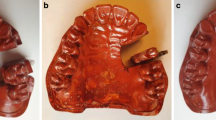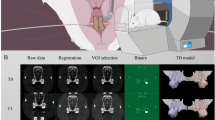Abstract
The abnormal occlusal contact can disrupt the coordination and health of the oral jaw system. Therefore, the dynamic adjustment of the occlusal surface is of great significance for assessing the status of occlusal contact and clarifying jaw factors of stomatognathic system diseases. To solve this problem, a trajectory subtraction algorithm based on screw theory to improve the accuracy of the occlusal movement trajectory is proposed in our paper. Driving by the relative trajectory, a virtual dynamic occlusal adjustment system is developed to realize 3D occlusal movement simulating, automatic occluding relation detection, and automatic occlusal adjustment. Furthermore, we adapt an active occlusal adjustment method based on Laplacian deformation to increase the contact areas of the occlusal surface, which can aid dentists to realize the automatic adjustment of the non-interference regions. As a consequence, the proposed subtraction algorithm is feasible and the root-mean-square is 0.097 mm, and the adjusted occlusal surface is more consistent with the natural occlusal morphology.

ᅟ












Similar content being viewed by others
References
Bohner LOL, Neto PT, Ahmed AS et al (2016) CEREC chairside system to register and design the occlusion in restorative dentistry: a systematic literature review. J Esthet Restor Dent 28(4):208–220
Shigeta Y, Hirabayashi R, Ikawa T et al (2013) Application of photogrammetry for analysis of occlusal contacts. J Prosthodont Res 57(2):122–128
Majithia IP, Arora V, Kumar SA et al (2014) Comparison of articulating paper markings and T Scan III recordings to evaluate occlusal force in normal and rehabilitated maxillofacial trauma patients. Med J Armed Forces India 71(Suppl 2):S382
Warreth A, Doody K, Almohsen M et al (2015) Fundamentals of occlusion and restorative dentistry. Part II: occlusal contacts, interferences and occlusal considerations in implant patients. J Ir Dent Assoc 61(5):252
Yoo KH, Ha JS, Yoo JS (2007) Modeling Inlay/onlay prostheses with mesh deformation techniques [M]// computational science—ICCS, vol 2007. Springer, Berlin Heidelberg, pp 154–157
Fan Q L, Cheng X S, Dai N et al (2015) Virtual adjustment of the occlusal surface for complete denture tooth arrangement[C]// International Symposium on Bioelectronics and Bioinformatics. IEEE:156–159
Reich S, Brungsberg B, Teschner H et al (2010) The occlusal precision of laboratory versus CAD/CAM processed all-ceramic crowns. Am J Dent 23(1):53
Decerle N, Bessadet M, Munoz-Sanchez ML et al (2014) Evaluation of Cerec endocrowns: a preliminary cohort study. Eur J Prosthodont Restor Dent 22(2):89–95
Arslan Y, Bankoğlu GM, Karakoca NS et al (2016) Comparison of maximum intercuspal contacts of articulated casts and virtual casts requiring posterior fixed partial dentures. J Prosthodont
Zafar H, Eriksson PO, Nordh E et al (2000) Wireless optoelectronic recordings of mandibular and associated head-neck movements in man: a methodological study. J Oral Rehabil 27(3):227–238
Pinheiro AP, Pereira AA, Andrade AO et al (2011) Measurement of jaw motion: the proposal of a simple and accurate method [J]. J Med Eng Technol 35(3–4):125–133
Wiesinger B, Häggman-Henrikson B, Wänman A et al (2014) Jaw-opening accuracy is not affected by masseter muscle vibration in healthy men [J]. Exp Brain Res 232(11):3501–3508
Pinheiro PF Jr, da Cunha DA, Filho MG et al (2012) The use of electrognathography in jaw movement research: a literature review. Cranio 30(4):293
Jankelson B, Hoffman GM, Hendron JA (1953) The physiology of the stomatognathic system. JADA 46:375–386
Wieckiewicz M, Zietek M, Nowakowska D et al (2014) Comparison of selected kinematic facebows applied to mandibular tracing. Biomed Res Int 2014(3):818694
Kijak E, Lietzkijak D, Frączak B et al (2014) Assessment of the TMJ dysfunction using the computerized facebow analysis of selected parameters. Biomed Res Int 2015(1):9
Santos ICT, Tavares JMRS, Mendes J et al (2008) A prototype system for acquisition and analysis of 3D mandibular movement. Int J Mech Mater Des 4(2):173–180
Yuan F, Sui H, Li Z et al (2015) A method of three-dimensional recording of mandibular movement based on two-dimensional image feature extraction. PLoS One 10(9)
Zhao T, Yang H, Sui H et al (2016) Accuracy of a real-time, computerized, binocular, three-dimensional trajectory-tracking device for recording functional mandibular movements. PLoS One 11(10):e0163934
Furtado DA, Pereira AA, Andrade ADO et al (2013) A specialized motion capture system for real-time analysis of mandibular movements using infrared cameras. Biomed Eng Online 12(1):17
Korioth TW, Hannam AG (1994) Deformation of the human mandible during simulated tooth clenching. J Dent Res 73(1):56–66
Fang JJ, Kuo TH (2008) Modelling of mandibular movement [J]. Comput Biol Med 38(11–12):1152–1162
Popov S, Guenther J, Seidel HP et al (2007) Stackless KD-tree traversal for high performance GPU ray tracing [C]. In: Computer Graphics Forum. Blackwell Publishing, Oxford and Malden, pp 415–424
Sorkine O, Cohen-Or D, Lipman Y et al (2004) Laplacian surface editing[C]// Eurographics/acm SIGGRAPH symposium on geometry processing. ACM:175–184
Fushima K, Kobayashi M, Konishi H et al (2007) Real-time orthognathic surgical simulation using a mandibular motion tracking system. Comput Aided Surg 12(2):91–104
Rinke S, Pabel AK, Rödiger M et al (2016) Chairside fabrication of an all-ceramic partial crown using a zirconia-reinforced lithium silicate ceramic [J]. Case Rep Dent 2016(9):1354186
Enciso R, Memon A, Fidaleo DA et al (2003) The virtual craniofacial patient: 3D jaw modeling and animation. Stud Health Technol Inform 94:65–71
Koseki M, Niitsuma A, Inou N et al (2007) Three-dimensional display system of individual mandibular movement[M]// Complex Medical Engineering. Springer, Japan, pp 117–127
Acknowledgments
We also thanks very much for editors with your attention to our paper.
Funding
This study was financially supported by the National Natural Science Foundation of China (Nos. 81271181, 51775273) and the Natural Science Foundation of Jiangsu Province of China (No. BK20161487), Six talent peaks project in Jiangsu Province, China (No. GDZB-034), Jiangsu Province Science and Technology Support Plan Project, China (No. BE2016010-4), and Jiangsu Province Achievements Transformation Project (No. BA2016106).
Author information
Authors and Affiliations
Contributions
SK Tian has contributed significantly in research design, drafting of the manuscript and analysis of data. N Dai has contributed significantly in research design and revision of the manuscript. XS Cheng has contributed significantly in acquisition of data and revision of the manuscript. LL Li has contributed significantly in analysis of data, theoretical guidance and condition support. YC Sun has contributed significantly in research design, theoretical guidance and condition support. HH Cui has contributed significantly in analysis and acquisition of data. All authors have read and approved the final submitted manuscript.
Corresponding authors
Ethics declarations
Conflict of interest
The authors declare that they have no conflict of interest.
Rights and permissions
About this article
Cite this article
Tian, S., Dai, N., Cheng, X. et al. Relative trajectory-driven virtual dynamic occlusal adjustment for dental restorations. Med Biol Eng Comput 57, 59–70 (2019). https://doi.org/10.1007/s11517-018-1867-3
Received:
Accepted:
Published:
Issue Date:
DOI: https://doi.org/10.1007/s11517-018-1867-3




